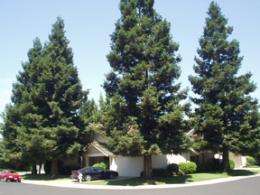New Study: Home Energy Savings Are Made in the Shade

(Â鶹ŇůÔşOrg.com) -- Trees positioned to shade the west and south sides of a house may decrease summertime electric bills by 5 percent on average, according to a recent study of California homes by researchers from the National Institute of Standards and Technology and the U.S. Department of Agriculture.
The first large-scale study of its kind, the research paper considers the effects of shade on 460 single-family homes in Sacramento during the summer of 2007 and provides hard statistics showing how well-placed shade trees can reduce energy costs and atmospheric carbon, as well.
“People have known for a long time that trees have multiple benefits for people, but we’ve quantified one of them for the first time using actual billing data and put a dollar value on it,” said NIST’s David Butry, who authored the paper with Geoffrey Donovan of the USDA Forest Service’s Pacific Northwest Research Station.
The study’s findings included:
• Planting trees on the west and south sides of a house decreased summertime electricity use, but planting them on the north actually increased it. Those on the east had no effect.
• Fast-growing trees provide better help than do smaller ones, and placement of the trees, particularly the distance from the house, is a significant factor.
• A London plane tree, planted on the west side of a house, can reduce carbon emissions from summertime electricity use by an average of 31 percent over 100 years.
This last finding was particularly significant to Butry, who said that trees not only reduce the carbon produced by the local gas or coal-fired power generator, but also remove carbon dioxide—a greenhouse gas—from the atmosphere.
“Trees sequester carbon in addition to providing shade,” Butry said. “We measured how much these shade trees reduced the carbon created by burning fuels to produce the electricity, and found that the trees also sequestered an equivalent amount of carbon on top of that. So there’s a double benefit.”
Utility companies from as far away as South Korea and South Africa have contacted the team about expanding the study, which was limited to a single season in a single city.
“It would be really interesting to look at how the effect varies across regions of the U.S. and of the world, and to see what happens in wintertime,” Butry said. “Sacramento Municipal Utility was very helpful in providing us with the data we needed. But future studies will depend on who has data and shares it with us.”
More information: G.H. Donovan and D.T. Butry. The value of shade: Estimating the effect of urban trees on summertime electricity use. Energy and Buildings June, 2009, 662-668. doi: 10.1016/j.enbuild.2009.01.002.
Provided by National Institute of Standards and Technology ( : )















